Handling

The Optimal Material Handling Lift for Rolls, Drums, Pallets, or Boxes
In today’s industrial market, finding a material handling lift is not difficult. Finding the right handling machinery for specific operations in often spacially challenged environments, however, is another thing altogether.
It is not an easy task but that is why we are here.
Meeting Your Specific Needs for Material Lifting Equipment Is Our Core Competence
With our industrial material handling equipment we have helped our customers lift and handle everything from fighter jet parts to contact lenses to Swiss cheese. Thus we know that each lifting and handling operation is unique. Odd shapes, unusual handling requirements, or challenging environments are no hindrance.

With our innovative and reliable design we are proud to have delivered countless custom material handling solutions to all sorts of industries.
However, even though we cherish the broadness and diversity of our customer base, we have particular extensive and longstanding knowledge of the special needs and requirements in:
• The pharmaceutical / biotech industry
• The food and beverage industry
• The storage industry
But again, we exclude no industry on the basis of no prior experience. On the contrary, we always embrace a new challenge and see it as a welcome opportunity to lift innovation even higher.
Thus we have been priveledged to deliver both standard and customized complex material handling solutions to other industries such as cosmetics, packaging, auto, filtration, electronics, retail, computer/server, semiconducters, aircraft, battery, machine builders and offshore.
We exclude no material handling lift needs as long as we can guarantee that we can meet the requirements. In that same vein, if the need isn’t customization, we are also very happy to provide a wide range of standard material handling lifts, which can be easily applied to the more common handling tasks (e.g. our C-Line lifts (light and agile) or N-Line lifts (versatile and strong)).
The Strength of Modular Design
– The Quest of Matching the Right Lifter with the Right Lifting Tool
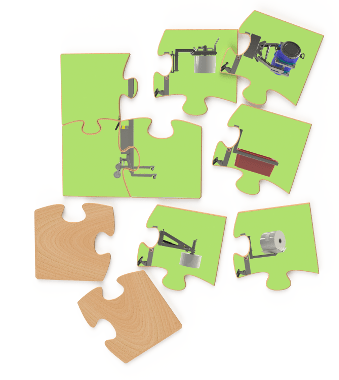
Matching the optimal lifter components in shape, size and tool type can be like trying solving a difficult puzzle: you need to combine the environmentally optimal material handling lift with the right lifting tool, the end-effector (be that forks, platforms, mandrels, crane arms or clamps).
However, with our innovative and flexible 2Lift Modular Design, it is easy to combine the appropriate lifter and lifting tool / end-effector.
Because of the endless examples of what needs to be lifted – be that rolls / reels, content in drums or boxes or items on pallets, it is important to find the right end-effector that can meet both the right shapes and sizes of items to be lifted, as well as the specific handling operation needed to be performed.
In this way we don’t just deliver a product, we deliver a whole solution – a solution that will accommodate both the handling operation and the environment in which it is done.
And since our lifers and lifting tools can literally be combined into endless combinations, don’t hesitate to contact us so that we can discuss which solution will fit your specific needs.
For now, we’d like demonstrate how we may help you find the right material handling lift to handle rolls and reels, drums and barrels, pallets and boxes.
Roll Lifting Equipment, Drum Handler, Pallet Lifter, and Handling Boxes
We have many years of experience of product development under our belt when it comes to roll handling (also commenly referred to as reel handling), drum handling, box and pallet lifting.
In the design process of every material handling lift, we always go to great length to take as many handling and environmental factors into consideration as possible.
When we receive an order for a lift, it is essential for the development of the optimal solution that we have in-depth understanding of a customer’s needs and requirements:
Roll Lifting Equipment for Roll / Reel Handling
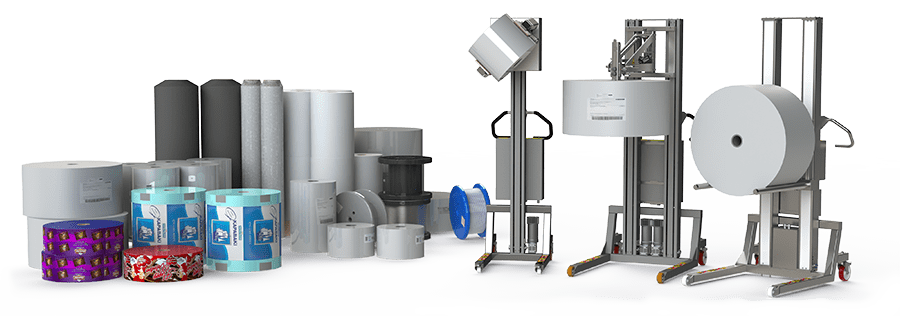
What Characterizes Your Roll / Reel?
– Shape, Size and Surface
First of all, reels and rolls vary in dimension, weight, and core diameter, but also the surface of your rolls is of great importance.
The surfaces of the reels vary greatly in themselves but the choice of material from which they are built be that e.g. plastic, paper, rubber, textile, or metal play a large role, too, making the ideal grippers for one type of roll unsuited for another.
What Is Your Roll Handling Operation?
All depending on what your purpose is with the roll handling, lifting rolls – as well as tipping or turning them – may be required.
The most common procedure for roll handling is gripping the roll directly through its core.
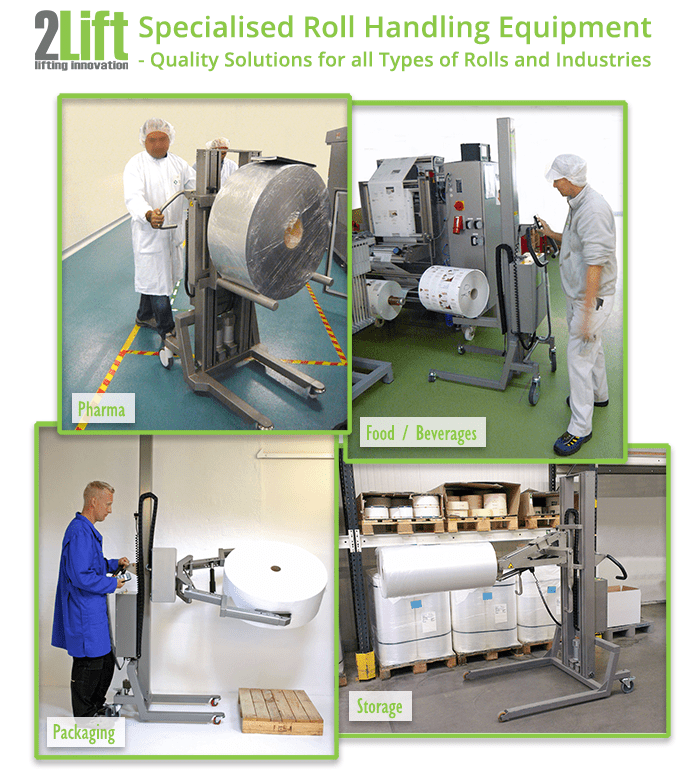
However, sometimes that is not possible due to the placement of a shaft. In that case, a solution may consist of clamping of the outer surface of the roll.
Another issue we often encounter is the risk of the roll telescoping when being lifted. To prevent such an event, we have several different solutions available, e.g. once again, we may use a clamping solution on the outer surface of the roll, or we may build a support system at the bottom of the roll before tipping.
How and Where Are Your Rolls Delivered?
When receiving rolls from suppliers, the rolls are placed in a certain environment which may be characterised by restricted access. On top of that the rolls are stacked and packed in a particular manner. These conditions are important elements we take into consideration when we design our roll lifting equipment.
Discover more about how we may help you finding the right roll lifting equipment or contact us directly to see how we may help you.
Drum Lift for Drum Handler Operations
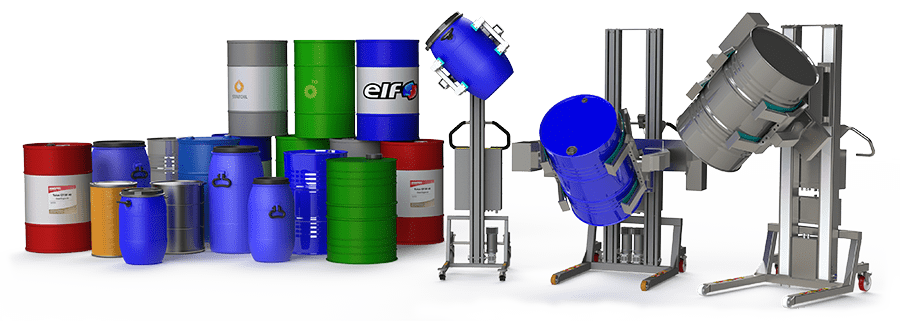
What Characterizes Your Drums?
– Shape, Size, Geometry and Surface Material
Just like rolls, drums and vessels, too, come in many different shapes and sizes. And again, the surface material, here in the case of the drum, vessel, or barrel, dictates which methods are used for gripping and handling.
More often than not, a drum can be squized without being deformed, but particularly thin walled drums can be difficult to handle, since squeezing during gripping may deform the drum in an undesired manner. Fortunately we also take measures to ensure the handling of more delicate drums or vessls.
What Tasks Is Your Drum Handler to Perform?
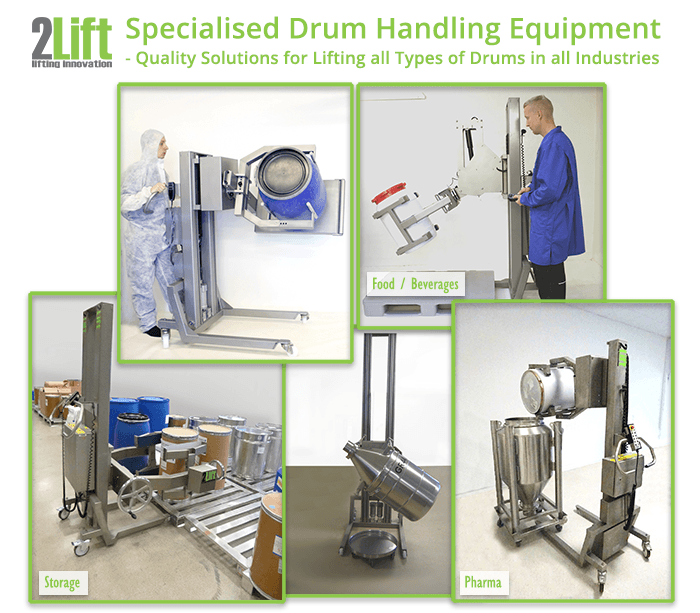
The drum handling procedure may vary from simple movements from place to place, to more advanced tipping, rotating and docking operations.
A simple drum lift operation may consist of:
- Lifting the drum from a storage area to a place where its contents is needed
- Moving the drum back to storage
A more complex drum handler operation might be:
- First the drum handler needs to lift your drum and then move it onto e.g. a scale
- Then the drum may need to be moved to an environment where you need to tip it sideways so the powder or liquid from inside it is poured into a funnel. When tipping/turning is desired, this may be done in a forwards or sidewards motion in relation to the lifter, depending on the space available
- Then at the end, you may need to bring back the empty drum to be stored or cleaned
All in all many factors need to be considered before we can help you find the ideal solution to your drum handling requirements.
Read more about drum handling here or contact us to discover how we may help you.
Pallet Lifter / Electric Pallet Stacker
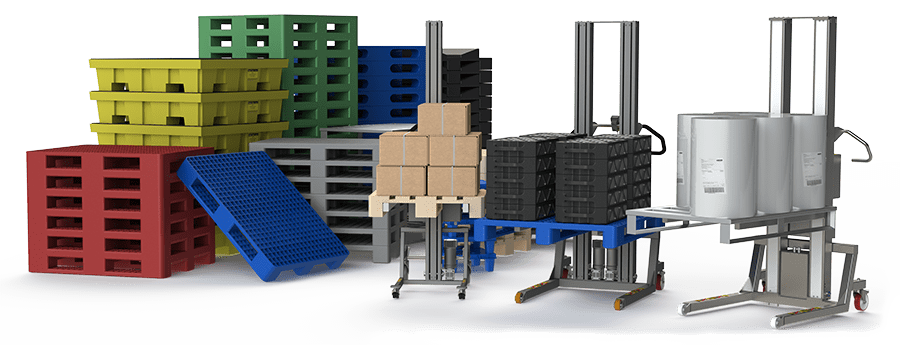
What Characterizes Your Pallets?
– Shape, Size and Material
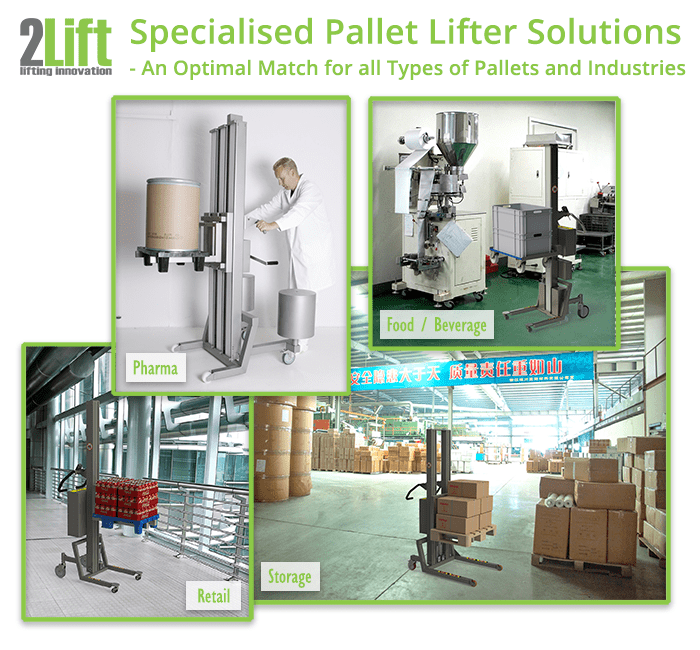
Used in practically all industries, pallets are found in all manner of shapes and sizes.
Depending on use, wood, plastic, or aluminium are the typical materials of choice.
Many standard electric pallet stackers are available for lifting and handling pallets with standard dimensions; however pallets for more specialised use will often require a custom built fork to accommodate the dimensions.
An example of such an instance could be to accommodate custom made pallets from the pharmaceutical industry or special pallets designed to carry trays of contact lenses which requires specialised fork dimensions for handling.
What Tasks Is Your Pallet Lifter to Perform?
Usually, pallet handling only requires lifting and moving the pallet. But we also encounter more advanced handling needs like being able to turn or tip the pallet for e.g. special storage or cleaning requirements.
Whatever you need for pallet handling may be, standard or specialised, we offer a wide range of pallet lifter solutions and are always ready to modify existing solutions or design something new. You are very welcome to contact us to find our more.
Industrial Material Lifting Equipment for Boxes
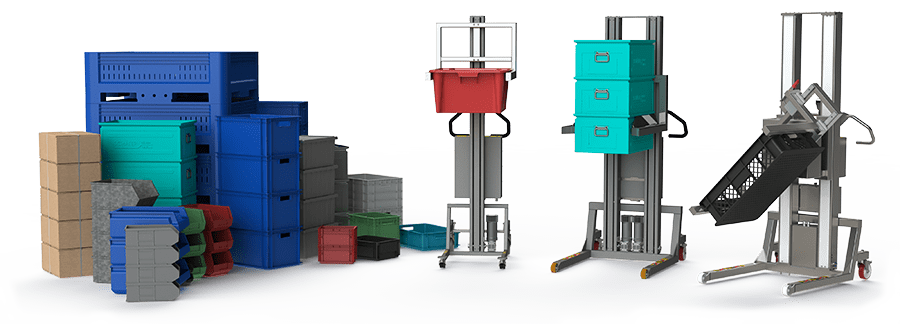
What Characterizes Your Boxes?
– Shape, Size and Material
Boxes are the most abundantly used storage containers in industry and come in all shapes and sizes.
The great diversity of geometry is also reflected in the many types of box material: from cheap cardboard boxes for common storage, to plastic boxes used in the food and beverage industry to stainless steel boxes intended for clean-room use.
What Industrial Material Handling Tasks Is Your Material Handling Lift to Perform?
But the tasks grow more complex when the filling or emptying of boxes is required.
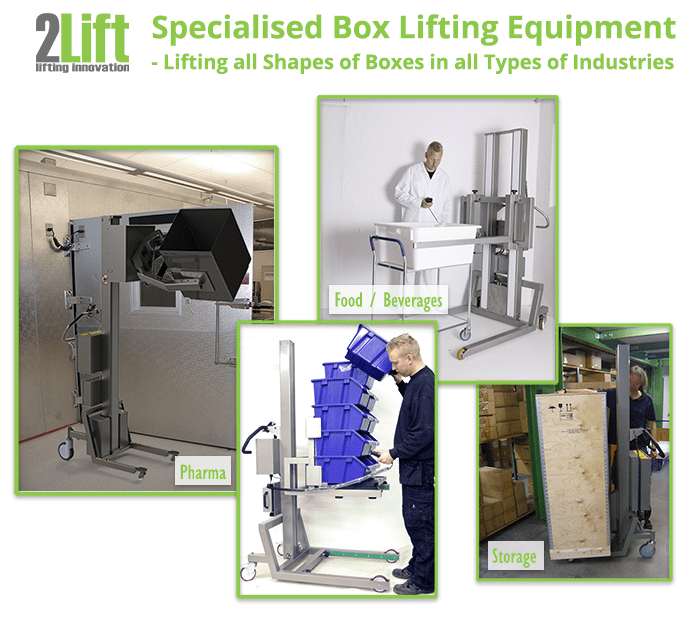
Just like in the case of handling of drums, operations may be fairly simple in terms of e.g. just needing to move boxes to and from storage.
We offer a wide variety of lifting tools (end-effectors, primarily forks and clamps) that allow handling of almost any type of box.
If We Don’t Already Have a Solution, We Will Design It!
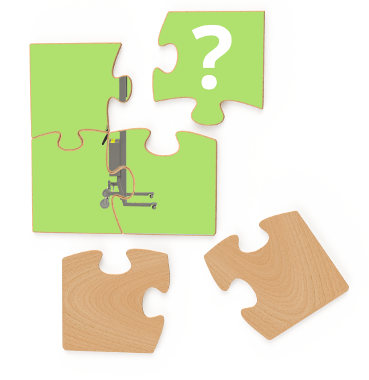
Apart from the common items mentioned above (rolls, drums, pallets, and boxes), we pride ourselves on finding solutions for lifting and handling almost anything you might come up with (within the 500 kg weight limits of our lifters. The weight limit is including the weight of the lifter tool).
Contact us and describe what you need handled and chances are that we have previously designed a solution for something similar.
If not, we will do our utmost to design a new material handling lift solution that fulfils your requirements. For inspiration, you might want to take a look at our custom solution handling machinery section.
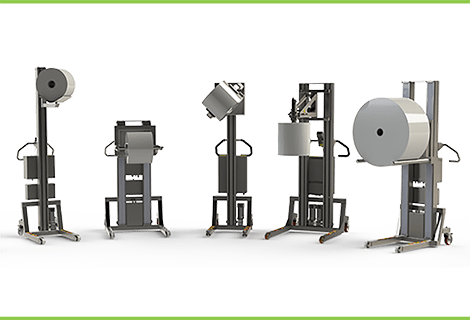
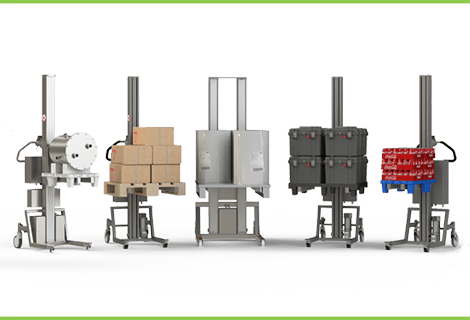
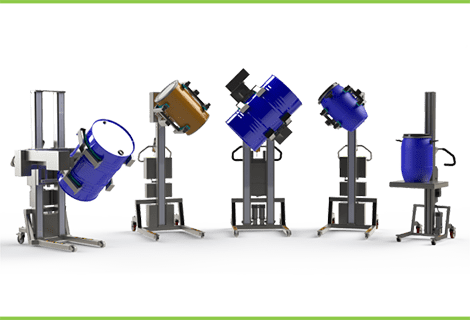
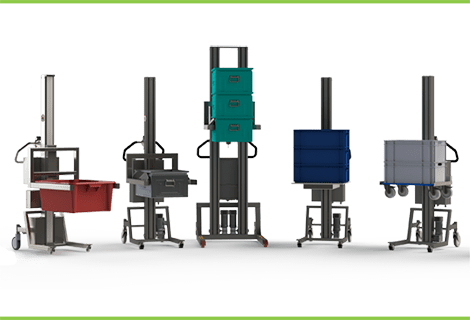
Go to our Homepage.

